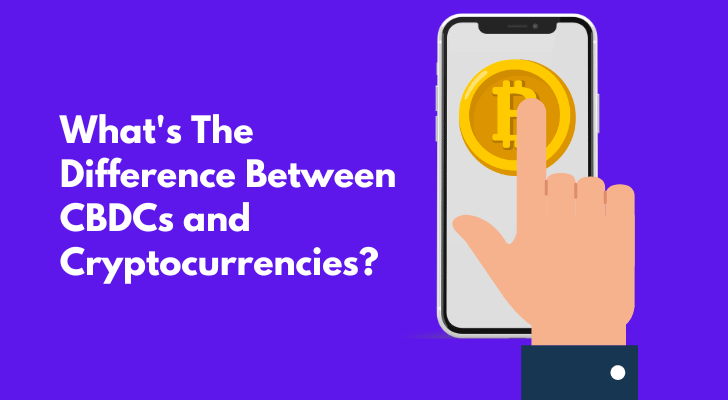As the field of digital transactions advances, it can be difficult to stay ahead of the curve. Take a look at two of the most talked about payment options right now: Central Bank Digital Currencies (CBDCs) and cryptocurrencies. You may have heard of both and thought that they have similar functions, but there are actually some key differences between them. Looks like both are set to shape the future of the world economy. So which is better, and should you get them if you haven’t? Let’s check this out.

Did You Know?
- Global Involvement: As of early 2023, over 80% of central banks were actively exploring CBDCs (Bank for International Settlements - BIS).
- Pilot Programs: Around 40 countries had initiated CBDC pilot programs by the end of 2022 (Atlantic Council CBDC Tracker).
- Fully Launched CBDCs: As of 2023, at least 10 countries had fully launched a digital currency (Atlantic Council CBDC Tracker).
- Public Interest: A survey found that 60% of respondents are interested in using a CBDC in the future (Mastercard, 2021).
- Consumer Readiness: Approximately 20% of the population in countries exploring CBDCs are ready to use them once available (BIS).
- Reduction in Cash Use: Countries with declining cash usage are 25% more likely to explore CBDCs (BIS).
- Efficiency in Transactions: CBDCs could reduce the cost of cross-border transactions by up to 80% (International Monetary Fund).
What are CBDCs as Opposed to Cryptocurrencies?
CBDCs are Central Bank Digital Currencies. They are digital versions of fiat currencies, like the US dollar or the Euro. CBDCs are created and regulated by central banks.
In other words, CBDCs, are fiat currencies issued by central banks in a digital format. CBDCs can be used by the general public and are backed by the full faith and credit of the issuing central bank.
Cryptocurrencies, as you know, are virtual tokens that use cryptography to secure their transactions. Cryptocurrencies are decentralized, which means no single entity or government controls them.
How are CBDCs and Cryptocurrencies different?
The purpose of digital currencies was to optimize the existing financial system by integrating with it, but cryptocurrencies were initially created to eventually replace it.
Cryptocurrencies are designed to be used as payments or investments and can be transferred between users without the need for intermediaries.
On the other hand, CBDCs are digital versions of fiat currency issued by a central bank and regulated by government authorities with strict anti-money laundering rules in place. Unlike cryptocurrencies, which rely on peer-to-peer transactions, CBDCs must go through centralized payment systems to remain compliant with applicable laws.
Additionally, CBDCs have built-in features to prevent double spending while also offering greater stability than their counterparts due to their backing from central banks.
Did You Know?
- Financial Inclusion: Around 50% of central banks exploring CBDCs cite financial inclusion as a primary motivation (World Bank).
- Potential Impact on Banking: A survey indicated that 70% of bankers believe CBDCs will impact their business (PwC).
- Consumer Privacy Concerns: About 40% of people cite privacy as a major concern regarding CBDCs (Mastercard, 2021).
- Interest in Emerging Economies: 70% of CBDC projects are in emerging economies (Atlantic Council CBDC Tracker).
- Fraud Reduction Potential: CBDCs could reduce money laundering and fraud activities by up to 10% globally (IMF).
- Central Banks' Pilot Duration: The average pilot program for a CBDC lasts about 18 months (BIS).
- Private Sector Involvement: Around 30% of CBDC projects actively involve the private sector in development (World Bank).
Examples of CBDCs
Examples of CBDCs include China’s DCEP (Digital Currency Electronic Payment), Sweden’s eKrona, Finland's Avant, Uruguay’s e-peso and Jamaica's Sand Dollar. These examples demonstrate how different countries have taken advantage of the potential that digital currencies offer to facilitate faster, more secure financial transactions;
- Reduce costs for both consumers and businesses.
- Improve access to financial services for those without bank accounts.
- Increase competition between banks.
- Create new opportunities for businesses and individuals. And
- Encourage innovation in finance.
If you want to learn about digital currencies and how you can invest them wisely, I recommend you to take this course - Crypto Quantum Leap by a multi-millionaire investor.
Pros and Cons of CBDCs
Proponents of CBDCs argue that they could help reduce crime and increase financial inclusion. They could also make it easier for central banks to conduct monetary policy and manage money supply.
Critics worry that CBDCs could lead to more government control over people's lives and could be used to track people's spending habits.
There is also concern that CBDCs could destabilize the banking system if they were widely adopted.
Pros:
- Faster Transactions: Compared to traditional methods like wire transfers, CBDCs can be transferred almost instantaneously.
- Reduced Costs: Because CBDCs are digital, there are reduced costs associated with their production and distribution.
- Increased Security: CBDCs are more secure than physical currency, as they cannot be counterfeited or stolen.
- More Accessible: CBDCs can be accessed by anyone with an internet connection, which gives them the potential to reach a global audience.
- Flexible: CBDCs can be used in a variety of ways, including online payments, in-app purchases, and person-to-person transfers.
Cons:
- Volatile Value: The value of CBDCs is subject to fluctuation, as they are not backed by a physical asset.
- Lack of anonymity: Unlike cash, CBDC transactions can be traced back to the individuals involved. This could pose a privacy concern for some users.
- Centralized control: Because CBDCs are issued by central banks, there is a risk of government control and manipulation.
Did You Know?
- Retail CBDCs vs. Wholesale CBDCs: 60% of ongoing CBDC projects are retail-focused, while 40% are wholesale (IMF).
- Blockchain Technology Usage: Approximately 65% of CBDC projects are using some form of blockchain or distributed ledger technology (DLT) (PwC).
- Economic Impact: CBDCs could increase a country's GDP by up to 3% through improved financial efficiency (IMF).
- Consumer Adoption Rates: Early adopters of CBDCs are projected to account for 15% of the population in participating countries (BIS).
- Security Investments: Central banks are investing up to 20% more in cybersecurity due to CBDC initiatives (PwC).
- Global Standards Development: Over 50 international organizations are involved in developing global standards for CBDCs (BIS).
Pros and Cons of Cryptocurrencies

Cryptocurrencies, like any new technology, have both advantages and disadvantages. Here are some of the key pros and cons of cryptocurrencies:
Pros:
- Cryptocurrencies are digital and therefore can be easily transferred or exchanged online without the need for physical money or bank involvement.
- Transactions made using cryptocurrencies are generally fast and inexpensive.
- Cryptocurrencies are decentralized, meaning they are not controlled by governments or traditional banks. This could make them more stable in the long term than fiat currencies which can be subject to inflation.
Cons:
- Cryptocurrencies are still a relatively new technology and therefore their price is highly volatile. Prices can fluctuate wildly from day to day, making them a risky investment.
- Because cryptocurrencies are decentralized, they may be used for illegal activities such as money laundering or drug trafficking.
Which is Better? CBDCs or Cryptocurrencies?
At first, I was really into cryptocurrencies. I loved the idea of a decentralized currency that wasn't controlled by any central authorities. But then I started to look into CBDCs (central bank digital currencies) and I realized that they are actually a much more realistic option.
CBDCs are still in the early stages, but many countries are already experimenting with them and it's only a matter of time before they become mainstream. With CBDCs, you don't have to worry about volatile prices or being hacked, because they are backed by a central authority.
In my opinion, CBDCs are the future of money and I'm excited to see how they develop over time.
Conclusion
CBDCs and cryptocurrencies are two different digital payment technologies with their own unique characteristics. While CBDCs are centralized, government-backed forms of digital money that offer citizens access to fast and secure transactions, cryptocurrencies provide users with a decentralized form of virtual currency that relies on blockchain technology for security. Each has its pros and cons but ultimately it is up to the individual user to decide which best suits their needs.

